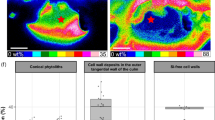Abstract
Time-resolved fluorescence spectroscopy was used to characterize water-soluble organic matter (WSOM) which plays an important role in soil ecosystem processes. WSOM was extracted from plant biomass, animal manures, and soils from controlled cropping systems studies with known histories of organic amendments. Lifetime constants were derived using the multi-way PowerSlicing method which provides a non-iterative, multi-exponential fitting of decay profiles. The lifetimes obtained by PowerSlicing were not significantly different from those obtained using the traditional discrete components analysis. The three components attributed to WSOM had lifetimes of 0.38 ± 0.14, 2.11 ± 0.72, and 7.08 ± 1.18 ns which are in agreement with previous lifetimes reported for humic substances. This study provides further support for the new paradigm for the structure of soil organic matter where the organic matter is composed of low-molecular-weight components held together by hydrogen bonding and hydrophobic interactions.






Similar content being viewed by others
References
Zsolnay A (1996) In: Piccolo A (ed) Humic substances in terrestrial ecosystems. Elsevier, Amsterdam
Morel F, Hering JG (1993) Principles and applications of aquatic chemistry. John Wiley & Sons, New York
Stevenson FJ (1994) Humus chemistry: genesis, composition, reactions. John Wiley & Sons, New York
Senesi N (1990) Anal Chim Acta 232:77–106
Clark CD, Jimenez-Morais J, Jones G, Zanardi-Lamardo E, Moore CA, Zika RG (2002) Marine Chem 78:121–135
Cook RL, Langford CH (1995) Anal Chem 67:174–180
Kumke MU, Tiseanu C, Abbt-Braun G, Frimmel FH (1998) J Fluorescence 8:309–318
McGown LB, Hemmingsen SL, Shaver JM, Geng L (1995) Appl Spectrosc 49:60–66
Engelsen SB, Bro R (2003) J Magn Reson 163:192–197
Ohno T, Bro R (2006) Soil Sci Soc Am J 70:2028–2037
Zhou LX, Wong JWC (2000) J Environ Qual 29:1852–1856
Ainsworth CC, Friedrich DM, Gassman PL, Wang Z, Joly AG (1998) Geochimca 62:595–612
Holtom GR (1990) SPIE 1204:2–12
Sidiropoulos ND, Bro R (2000) J Chemometr 14:229–239
Harshman RA (1970) UCLA Working Papers in Phonetics 16:1–84
Bro R (1997) Chemometr Intell Lab 38:149–171
Stedmon CA, Markager S, Bro R (2003) Marine Chem 82:239–254
Sutton R, Sposito G (2005) Environ Sci Technol 39:9009–9015
Acknowledgements
This project was supported by National Research Initiative Competitive Grant no. 2003–35107–13628 from the USDA Cooperative State Research, Education, and Extension Service, and has also been supported by Hatch funds provided by the Maine Agricultural and Forest Experiment Station. Part of this research was performed at the W.R. Wiley Environmental Molecular Sciences Laboratory, a national scientific user facility at PNNL managed by the Department of Energy’s Office of Biological and Environmental Research. Pacific Northwest National Laboratory is operated for the US Department of Energy by Battelle under Contract DE-AC06–76RLO 1830. This is journal number 2995 of the Maine Agricultural and Forest Experiment Station.
Author information
Authors and Affiliations
Corresponding author
Rights and permissions
About this article
Cite this article
Ohno, T., Wang, Z. & Bro, R. PowerSlicing to determine fluorescence lifetimes of water-soluble organic matter derived from soils, plant biomass, and animal manures. Anal Bioanal Chem 390, 2189–2194 (2008). https://doi.org/10.1007/s00216-008-1963-6
Received:
Revised:
Accepted:
Published:
Issue Date:
DOI: https://doi.org/10.1007/s00216-008-1963-6




